by Thomas Maes (1)
What is marine litter?
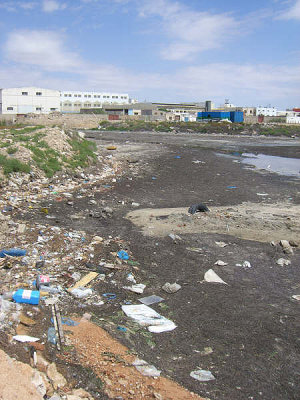
Some of us might wonder what marine litter is exactly and where it comes from. We all know the term “litter” and have seen it in some kind of form in our daily lives; an empty plastic bag drifting in the wind, cigarette butts on the pavements, empty drink bottles in the park or even remote idyllic places wasted by the presence of litter. What we see on land is not different from what is going on in the sea and thus the term “Marine Litter” has been introduced to describe discarded, disposed of, or abandoned man-made objects present in the marine and coastal environment. It consists of articles that have been made or used by people and, subsequently, deliberately discarded or accidentally lost. They originate from ocean-based (fishing vessels, cargo ships, stationary platforms, fish farming installations, pleasure crafts and other vessels) or land-based sources (littering, dumping, poor waste management practices, untreated sewage and storm water discharges, riverine inputs, industrial facilities, tourism, extreme natural events) and can be found all around the globe. Most sources of marine pollution are land based and some studies indicate that up to 80% of marine litter originates from land.
Marine litter, mainly plastic, poses a serious environmental threat to marine organisms, as well as a series of economical and social problems. The majority of marine debris is comprised of plastic materials — 60-80% overall and 90% of floating debris. About 70% of our planet is covered by water that is divided into several oceans and smaller seas, all connected and all dependent on each other. Because it is the principal component of Earth's hydrosphere, the world ocean is also integral to all known life, forms an integrated part of all cycles, and influences climate and weather patterns. This means that plastic waste of all sizes and shapes became a transboundary pollution problem with a powerful vehicle, the ocean!
How did it get so bad?
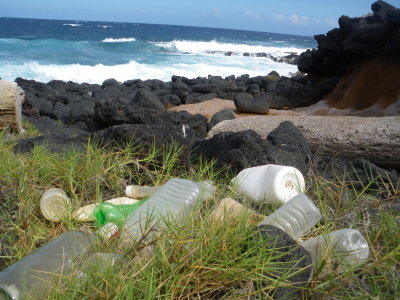
Consumerism, a social and economic order based on fostering a desire to purchase goods and services in even greater amounts, has been pushing society towards an ever-growing demand for plastic and single use items, which in turn has led to an accumulation of waste products all over the planet. From a young age onwards waste has been categorised as something dirty and worthless and thus humankind created landfills and garbage dumps where on a daily basis tonnes and tonnes of items gather to spend their end of life. The constantly expanding amounts of waste and slow degradability eventually led to an enormous surplus of mainly synthetic polymers commonly known as plastics. We gradually filled up the landfills and contaminated our waterways and rivers that connect the land to the sea and slowly but surely spoiled the marine environment with discarded man-made substances. Nowadays three times more rubbish is dumped into the world’s oceans each year as the weight of fish caught annually.
Since 1950, globally there has been an average annual increase in the production and consumption of plastics of 9%. From 1.5 million tonnes in 1950, total global production reached 245 million tonnes in 2008 and it will continue to grow, reaching over 365 million tons in 2015 and 540 million tons in 2020 (using a conservative annual rate of 6.5%). An analysis of plastic materials consumption on a per capita basis shows that this has now grown to approximately 100kg per year in NAFTA and Western Europe. These regions have the potential to grow to approximately 140kg per capita by 2015. The biggest potential growth area is the rapidly developing Asian countries (excluding Japan), where current per capita consumption is only around 20kg (2).
It is estimated that around 2.25 million pieces of litter are dropped in the UK every day, while an estimated 28.5 million tonnes of waste was collected in England alone every year (DEFRA 2008 figures). Evidence shows that a single one-litre soda bottle could break down into enough fragments to put one fragment on every mile of beach in the entire world. Consequently the density of plastic litter found on UK beaches has increased by 146% between 1994 and 2008. Small plastic pieces have been the number one item found since 1998. At least one item of litter is found on every 50 cm of beach in the UK (MCS Beachwatch Survey). When asked, 48% of the UK population admit to dropping litter, but remarkably 94% of the people thought dropping litter was a fairly or very irritating behaviour. In terms of enforcement only 44,000 fixed penalty notices were issued for littering offences in 2007/2008, which is negligible when compared to the amount of people admitting to litter (3).
(1) This commentary reflects the personal opinions of the author and is not intended to represent the opinions of Cefas or other agencies of the UK government.
(2) http://www.plasticseurope.org/Documents/Document/20100225141556-Brochure_UK_FactsFigures_2009_22sept_6_Final-20090930-001-EN-v1.pdf
(3) http://www.keepbritaintidy.org/KeyIssues/Litter/Default.aspx
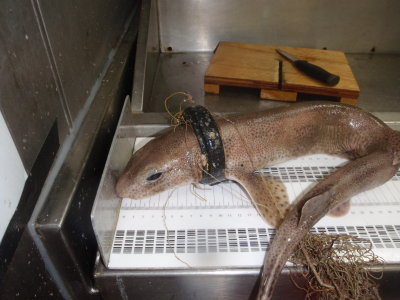
Other threats to wildlife are, for example, smothering of the seabed or environmental disturbances created by marine litter. It also causes damage to people, property and livelihood. People are affected when debris fouls boat propellers, clogs water intakes, blocks pumping systems or causes injuries in beaches and parks. Some estimate that the true economical cost could be easily up to €1 million/year or more for a small fishing community. In addition, the presence of debris along shorelines can lead to serious economic problems for regions that are dependent on tourism.
Micro-plastics?
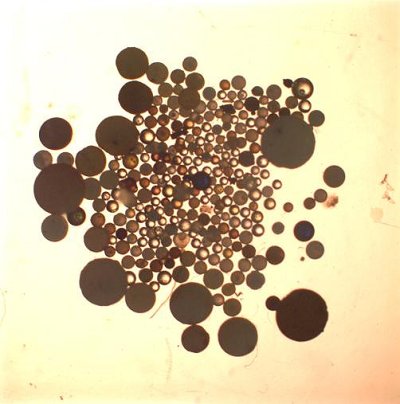
The lightness and durability of plastic makes it such a useful and versatile material for manufacturers but it also makes it a long-term problem for the environment. Plastics accumulate because they don't biodegrade like many other organic substances. Although they don’t degrade they do fragment in the environment, caused by a combination of mechanical forces like waves and/or photochemical processes triggered by sunlight. This means that plastic breaks down into smaller and smaller fragments, better known as micro-plastics. The origin of these fragments can be broken down fishing nets or lines, plastic bags, films and bottles, remains of oxo-biodegradable plastic, industrial raw material like pellets or other particular direct sources of micro-plastics like for example facial cleansers.
Recently, another source of micro-plastics has been identified, namely the shedding of synthetic fibres from textiles by washing of domestic clothes. Most of them seem to escape from treatment screens at waste water plants and eventually arrive in the ocean. Micro-plastics normally float on the surface because they are less dense than seawater, but the buoyancy and density of plastics may change during their residence at sea due to weathering and biofouling which means they are spread across the surface, water column and sediments. This steady but constant stream of micro-plastics has led to a significant increase in the ratio of plastic to plankton in the water. Because of their size they are available to a much broader range of organisms and have been shown to be ingested by several species ranging from lugworms, mussels, fish and even birds. The ingestion of micro-plastics by species at the base of the food web causes concern as little is known about its effects and transfer across trophic levels.
Contaminant pills?
To make matters worse, plastics leach toxic additives, used in the manufacturing of plastic materials (e.g. Tetrabromobisphenol A or TBBPA), when they arrive in the marine environment and take up and accumulate persistent organic pollutants (POPs) such as carcinogenic and endocrine-disrupting polychlorinated biphenyls (PCBs), polycyclic aromatic hydrocarbons (PAHs) and organochlorine pesticides while residing in the oceans. Plastic debris can attract and concentrate POPs up to a million times their levels in the surrounding seawater and when consumed by marine animals, the POPs endanger both the creatures that ingest them and organisms higher up on the food chain.
This means that the possible effects of micro-plastics on marine organisms after ingestion are possibly threefold: physical blockage or damage of feeding apparatus or digestive tract, leaching of plastic additives into organisms after digestion, and accumulation of sorbed chemicals from the particle towards the organism. But the effects don’t stop there; as micro-plastics are found in organisms at the base of our food webs they will accumulate when shifting up in the food web and thus could arrive back on our plates!
The most effective way to manage the marine litter pollution issue is by limiting the input, by changing ways and behaviours that cause marine debris to enter the environment in the first place. At the moment, only about 3.5% of generated plastic are recycled throughout the world and perhaps around 10% of produced plastic ends up in the sea each year (4). This means that at this point it is probably better to focus on limiting new inputs than trying to clean out what is there. Especially costly clean-up operations – e.g. fishing for litter schemes who compensate and send out fishermen to actively fish and collect marine litter should be avoided as they most likely have a further negative impact on the marine environment through sustained overcapacity of fishing fleets, by-catch and fuel consumption.
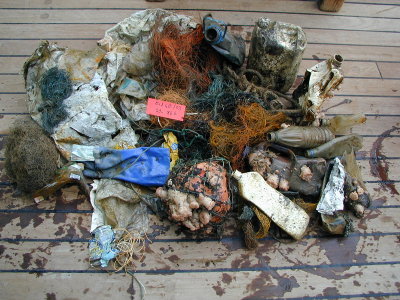
Retention and proper disposal of marine litter by fishermen should become mandatory without compensation; in the long term they will reap the benefits together with all of us. Statutory waste audits for all ships and the retention and disposal of litter caught by commercial fishermen will, of course, require an extension of port waste reception facilities (e.g. skip provision). Ports and fishermen are not the only ones, who need to be active and need reception facilities. Better facilities for litter collection in general are often lacking on beaches and in our daily environment. Overall, statutory cleaning, improved reception facilities and litter collection enforcement together with targeted educational programmes for the general public and involved stakeholders, should improve in order to drive changing behaviour towards littering.
Of course, we must reduce the production of litter and educate people not to litter, but in most countries in the world some of the plastic will always escape the preferred disposal routes and find its way into the open landscape or the ocean, from which it cannot realistically be collected. Obviously, we can reverse these trends by less or better use of plastic packaging, through the development of better designed plastics, better labelling and the promotion of local products and markets. If we can buy clearly marked dolphin-free tuna, why can we not buy plastic-free or environmentally friendly labelled products with plastics that convert at the end of their useful lives into materials which are truly biodegradable in the environment? Currently there is a lot of controversy in relation to biodegradable plastics and their effective breakdown, mainly because clear regulations are missing.
Another critical point that needs urgent attention is sewage overflow, a condition whereby untreated sewage is discharged into the environment prior to reaching treatment facilities. It thereby escapes waste water treatment even where treatment facilities exist. This overflow happens mostly because of heavy rainfall and sometimes by opening the overflows deliberately. This circumstance is most prevalent in cities whose sub-surface infrastructure is quite old – Paris, London, Stockholm, New York and Washington DC are typical examples of such locations. The U.S. Environmental Protection Agency estimates that about 40,000 overflow events occur in the United States alone each year. Other advanced European countries and Japan have similar or even somewhat larger frequencies of similar events.
Emerging economies discharge still about half of all sewage without treatment of any type. Typical debris from these sources includes street litter, industrial waste water, domestic effluents, raw sewage and medical waste. Improving the function, storage and efficiency of combined sewage overflows should effectively limit this input. Regrettably this usually implies rather high infrastructural costs, though China has successfully experimented with cheaper yet effective constructed wetlands as a result of international scientific cooperation (5).
Land based management
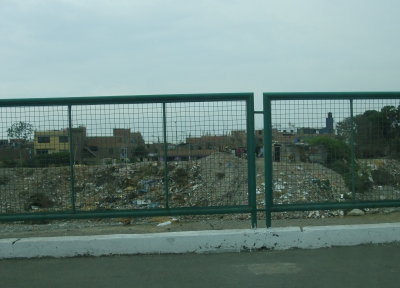
A lot of countries face significant barriers to the effective prevention and control of marine litter. In many cases, financial, cultural and awareness barriers may impede development of political will to address the problem. The problem is not typically one of developed countries or industrialised areas, although regional differences and pressures may leave different imprints.
A marine litter review in the East Asian Seas region concluded that the problem of marine litter is likely to be particularly severe in this region, due in part to the massive industrial and urban development in the coastal zones, combined with an exponential and sustained growth in shipping activity serving the region’s rapidly expanding economies, and the current lack of effective marine litter prevention and control measures in many surrounding countries (6). Lost or abandoned fishing gear is likely to be a part of this concern in the East Asian Seas region due to the large size of the fishing industry and lack of effective regulation, including high levels of illegal, unreported and unregulated fishing in the region.
The Caribbean experience shows that effective waste management at sea is in fact often a broader land management issue, i.e. dealing with the garbage collected on land is the biggest part of the problem. A country-by-country survey was necessary to influence policy and to make sure that ships’ waste and port reception facilities are integrated into national waste management plans. This requires regional standardisation of charges and changes to port-state control. As a result, port reception facilities and cost recovery mechanisms have to be introduced in all the Caribbean member states for the policy to be effective.
In the European Union alone, we throw away three billion tonnes of waste each year. This amounts up to about 6 tonnes of solid waste for every man, woman and child per year. Most of what we throw away is either burnt in incinerators or dumped into landfill sites (67%). By 2020, the Organisation for Economic Co-operation and Development (OECD) estimates that we could be generating 45% more waste than we did in 1995 (7). Unfortunately stockpiling waste is not a viable solution and simply destroying it is unsatisfactory due to the resulting emissions and highly concentrated, polluting residues.
Exporting waste legally or illegally to poor countries has become a vast and growing international business, as companies try to minimise the costs of new environmental laws that tax waste or require recycling or otherwise disposal in an environmentally responsible way. It is often much more expensive to incinerate or recycle in Europe than to put it on a boat overseas. There is no adequate enforcement in place to control this kind of trade and escape routes exist aplenty. The temptation to export waste is huge, because recycling at home gets more and more expensive due to Europe’s new environmental laws. Huge amounts of waste in the whole of the EU escape legal treatment. E-waste, for example, is often labelled as second-hand goods, which can be legally shipped, even though it is destined for dismantling.
(5) http://www.crc.uqam.ca/Peng/PDF/Liu_FEE-%20proof1.pdf
(6) http://www.cobsea.org/documents/Meeting_Documents/Marine%20Litter/Annex%206_%20Regional%20Review%20Pres.pdf
(7) http://ec.europa.eu/environment/waste/index.htm
The EU is aiming for a significant cut in the amount of rubbish generated, through new waste prevention initiatives, better use of resources, and encouraging a shift to more sustainable consumption patterns. Where possible, waste that cannot be recycled or reused should be safely incinerated, with landfill only used as a last resort. Both these methods need close monitoring because of their potential for causing severe environmental damage.
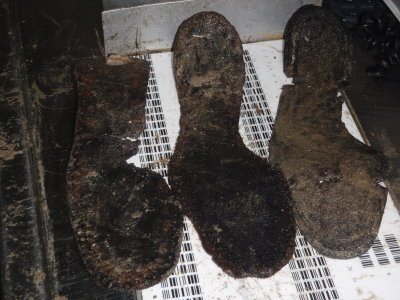
The EU has recently approved a Directive setting strict guidelines for landfill management. It bans certain types of waste, such as used tyres, and sets targets for reducing quantities of biodegradable rubbish. In February 2011, Members of the European Parliament (MEPs) passed new Waste Electrical and Electronic Equipment (WEEE) guidelines for electronic waste. The main objective of the WEEE Directive is to reduce the amount of WEEE that ends up in landfills, and to restrict the use of hazardous substances in the production of electrical and electronic equipment (EEE). Another recent Directive lays down tough limits on emission levels from incinerators. The Union wants to reduce emissions of dioxins and acid gases such as nitrogen oxides (NOx), sulphur dioxides (SO2), and hydrogen chlorides (HCl), which can be harmful to human health. The EU’s laws governing waste disposal also require more recycling of paper and plastic each year, and generally prohibit dumping in landfills, while incineration is now heavily taxed in most European countries (8). Local authorities are under increasing pressure to collect materials separately because of the EU Landfill Directive. This burden has been passed on to citizens, who are now required to sort a range of materials individually. Having to sort rubbish into numerous bins (up to 7) often frustrates taxpayers, even if they want to recycle. It places needless pressure on households and doesn’t encourage recycling in future. The regulations also prohibit exporting waste to poorer parts of the world, unless the receiving country accepts that type of waste and it is received by a certified recycler.
The European guidelines ban the export of certain hazardous materials and so-called “problematic” waste, defined as waste that is not amenable to recycling and so would be harmful to the environment at its destination, for example, waste that is soggy or mixed household garbage. The European laws generally follow the guidelines of the 1992 Basel Convention, the treaty that regulates dangerous exports of waste, and a proposed 1998 amendment (9). Unfortunately the United States of America was one of the few countries that did not ratify the convention; much of the trash trade banned by Europe is still legal in the US, where current laws focus on only the most hazardous waste.
Nevertheless some types of waste exports may be environmentally sound. If products and packaging used in Europe are manufactured in Asia it may make sense to ship them back for recycling. The waste trade, legal and illegal, is partly propelled by the fact that fast-growing economies like China and India need raw materials. The day we will see the value in litter will be the day nothing goes to waste. Recycled materials are cheaper than virgin ones; they reduce greenhouse gas emissions and the dependence on imports. And thus the primary objective is to couple waste to money. Seeing waste as a resource may be a powerful antidote to being submerged in rubbish in the coming decades.
Remarkably, a Life Cycle Assessment by the UK’s Environment Agency has shown that plastic carrier bags are the most environmentally sustainable option for carrying goods and protecting them from contamination. Replacing all plastic by organic products would put more stress on food production due to the spatial competition with edible crops. Transport costs and oil consumption would equally rise and have direct impacts on CO2 production. So instead of completely banning a product with clear pros and cons we should target the negative points and reduce, reuse and recycle single-use disposable products and packaging that often end up as waste. In order to do so we will need to reconsider the value we give to waste and exploit it as a resource instead of a disposable end-product.
(9) http://europa.eu/legislation_summaries/environment/waste_management/l28043_en.htm
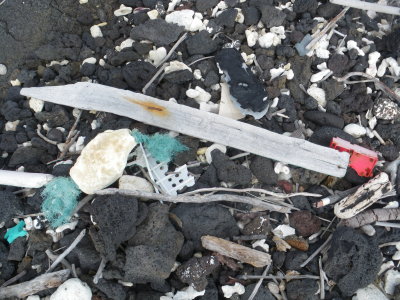
At the same time, millions of tonnes of waste are being sent for incineration or simple disposal inside or outside the EU. The opportunities we are trashing with the prevailing waste policies are just astonishing; especially when you think that half of the household waste is recyclable and the other half represent a “mistake” of industrial design that needs to be fixed. In both cases there should be a huge job opportunity – jobs in waste collection, jobs in reuse centres, jobs in repair shops, jobs in recycling, jobs in composting, jobs in designing better products, jobs in producing high-quality products with recycled material. All of these are jobs that cannot be delocalised and that we are demolishing with every tonne of waste we dump in landfills, send abroad or incinerate. The EU's waste management and recycling sector is very dynamic, but still offers economic opportunities with vast potential for expansion. In 2008, its €145 billion turnover represented around 1% of the EU's GDP and 2 million jobs. Compliance with EU policy would help create a sector with 2.4 million jobs and a total annual turnover of €187 billion.
Meeting the global challenge
The plastic litter problem has become a global problem requiring global solutions. Solutions should be based on sound science, including a global assessment, which collates the available scientific information and makes recommendations of use to the wide variety of policy, industry and societal organisations with responsibility in this area, down to waste management at local level. Policymakers will need to take an integrated view of the whole process and develop a range of options for guidelines and directives, including packaging and treatment of integrated waste management from collection to final disposal.
There is a clear need for improved legislation and wider litter strategies with involvement of key stakeholders, local governments and members of the public. In the end, the only sure solution is to prevent plastics from entering our waterways and reaching the sea. In order to reduce the sources of pollution, improved knowledge is critical. Scientific support, clarifying the involved key processes such as degradation, dynamics and impacts for example, but also looking at the economics, social and employment aspects, will be crucial to develop the required global standards and wider perspectives on marine litter. Building broad consensus around such integrated perspectives is the most promising approach to meeting the now global challenge of marine litter.
Click here for a video about marine litter produced by NOAA and the Smithsonian.








